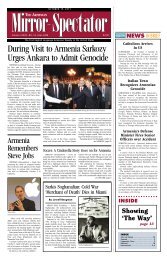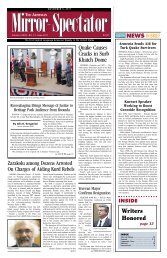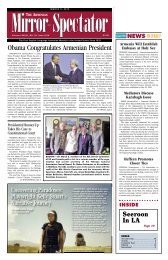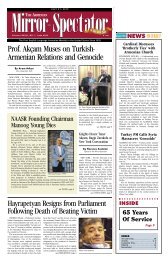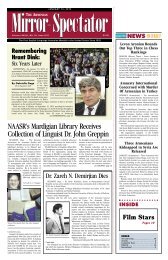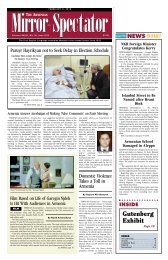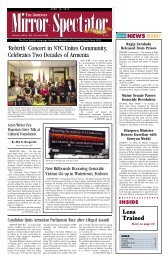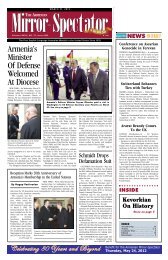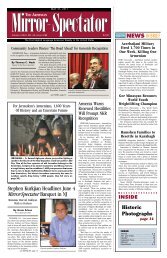Inspirational Vergin Mazmanian, 103, Dies Bipartisan Genocide ...
Inspirational Vergin Mazmanian, 103, Dies Bipartisan Genocide ...
Inspirational Vergin Mazmanian, 103, Dies Bipartisan Genocide ...
You also want an ePaper? Increase the reach of your titles
YUMPU automatically turns print PDFs into web optimized ePapers that Google loves.
The<br />
Family<br />
Tree<br />
How a Palestinian family from<br />
1930s Jaffa Ended up in the Heart<br />
Of a 2011 Israeli Political Storm<br />
By Dr. Rona Sela<br />
JERUSALEM (Haaretz) — The painting “The<br />
Citrus Grower,” whose recent acquisition for<br />
display in the Knesset caused a storm, is based<br />
on a portrait of a Palestinian family from Jaffa<br />
in the 1930s. The original photograph was<br />
taken by Elia Kahvedjian, a survivor of the<br />
Armenian <strong>Genocide</strong>. He was born in Turkey in<br />
1910, and experienced the death march with<br />
his family. He was saved by a Kurd whom they<br />
encountered along the way. His mother, who<br />
understood where they were headed — and who<br />
had already lost three other children since the<br />
start of the march — gave Elia, then a young<br />
child, to the Kurdish man to save him.<br />
After an arduous journey, and the loss of<br />
most of his family, Kahvedjian finally arrived in<br />
Nazareth with the help of the American Aid<br />
Association for the Near East. He got his love of<br />
photography from Borosian, a teacher at his<br />
boarding school in Nazareth. When he turned<br />
16, this love took Kahvedjian to Jerusalem,<br />
where he studied photography with the<br />
Armenian photographers Joseph Toumaian and<br />
Garabed Krikorian, and later started to work at<br />
the shop of the Hannania brothers, Christian-<br />
Arab photographers.<br />
The Armenians were among the local photography<br />
pioneers in Palestine in the second<br />
half of the 19th century, and Kahvedjian continued<br />
this glorious legacy. In 1940, he bought<br />
the shop from the Hannania brothers, and<br />
thereafter became a very active and successful<br />
photographer, opening two more shops at the<br />
end of Jaffa Road, near the Fast Hotel. There<br />
were numerous such shops in this area, including<br />
those owned by photographers Chalil Raad,<br />
Garabed Krikorian and Militad Savvides. After<br />
the war in 1948, the area became a no-man’s<br />
land. Alerted in advance, before the war, by<br />
friends in the British army, Kahvedjian was able<br />
to save his negatives and the contents of the<br />
store in time, and he opened a photography studio<br />
in the Christian Quarter of the Old City.<br />
The store has been located in the same place<br />
ever since and the work there has been carried<br />
on by Kahvedjian’s son Kevork and his grandson<br />
Elli.<br />
Throughout his life Kahvedjian was involved<br />
in Arab society in Palestine and documented<br />
scenes of daily life in cities and villages — chess<br />
games, women at a well, the plowing season, a<br />
Friday market, the orange harvest and more —<br />
many of them near Jerusalem, but also elsewhere,<br />
such as the Jaffa port. Copies of these<br />
photographs, produced from the original negatives,<br />
may still be purchased at Kahvedjian’s studio.<br />
He did not document the Old Jewish community<br />
of Jerusalem and avoided photographing<br />
the new Jewish-Zionist settlement. At the<br />
same time, Kahvedjian sometimes documented<br />
the consequences of the Arab struggle against<br />
the Jews, such as Jewish vehicles that were damaged<br />
and left by the side of the road in Bab el-<br />
Wad (known by Israelis as Sha’ar Hagay, on the<br />
road to Jerusalem).<br />
see FAMILY TREE, page 16<br />
S A T U R D A Y, J U N E 2 5 , 2 0 1 1<br />
T H E A R M E N I A N M I R R O R - S P E C TAT O R<br />
Arts & Living<br />
Robert Mardirosian (aka, Romard), in his basement art studio, on the day he admitted<br />
publicly that he had been secretly holding the Bakwin paintings for decades.<br />
The<br />
Lost Cézanne<br />
After Seven Paintings Were Stolen from Him in<br />
1978, Michael Bakwin Thought He’d Never See<br />
Them Again. Thirty Years Later, the Saga of the<br />
Missing Art — with Twists and Turns Worthy of a<br />
John Grisham Novel — Continues<br />
NEW YORK (Town and Country) — Two Enormous steel security gates block<br />
entry to Michael Bakwin’s rolling 48-acre estate in Ossining, nestled in New York’s<br />
Hudson River Valley. His parents built this Tudor-style manse — with 13 bedrooms<br />
and gardens so spectacular they’re on horticultural society tours — as a summer<br />
retreat back in 1932. Bakwin, now 77, lives here mostly in the summer, entertaining<br />
his children, grandchildren and great-grandchildren.<br />
Pressing a strong hand in greeting, he radiates an embracing warmth, which is<br />
reflected in the cozy flannel of his moss-colored button-down shirt. “Come,” he says,<br />
deftly taking my coat. “Let me show you the<br />
By Gretchen Voss<br />
views.” As I try to match his brisk gait<br />
through the narrow hallways, he apologizes,<br />
telling me that he wishes he could show off<br />
his art. But the works he still owns are now<br />
locked in a vault. “It makes me nervous even to have them,” he says, gesturing to<br />
the walls of windows that make up three sides of the great room. “There’s no way<br />
to secure this place.”<br />
Over a lunch of chicken salad and warm slices of crusty bread, Bakwin proves an<br />
engaging raconteur, with a mischievous twinkle in his bright green eyes. Get him<br />
chatting about his travels, or the croquet party he throws each summer, and he<br />
floats with lightness of a man born into privilege. It’s only when he speaks of “the<br />
burglary” that he suddenly wears of his age. His eyes, fixed in the distance, visibly<br />
darken.<br />
On the weekend before Memorial Day 1978, Bakwin, then 44, left what was at the<br />
time his primary residence on remote Hawthorne Road in Stockbridge, Mass., for a<br />
brief visit to Ossining. He doesn’t recall if he locked the front door before driving<br />
down the meandering unpaved driveway with his second wife and two young daughters.<br />
Even if he had, it wouldn’t have been hard for someone to get in; a front door<br />
key was tucked under a stone frog.<br />
Bakwin knows that sounds bizarre — ridiculous, even — considering there was artwork<br />
worth millions of dollars, including a much-admired and uninsured Cézanne,<br />
displayed throughout the house. But this was the Berkshires, summer playground<br />
for the Vanderbilts and counterculture refuge of the intellectual elite. One simply did<br />
see CÉZANNE, page 14<br />
13<br />
Bloomberg<br />
Television’s<br />
Lara Setrakian<br />
Talks Middle<br />
East Reporting<br />
NEW YORK (Bloomberg) — Lara Setrakian,<br />
Bloomberg Television’s reporter in the Middle<br />
East, joined the network in March. She is based<br />
in Bloomberg’s bureau in Dubai, currently its<br />
largest bureau in the Middle East, with more<br />
than 15 journalists covering markets, energy,<br />
finance, government and other news.<br />
Setrakian first began reporting from the<br />
Middle East in October 2007 for ABC News.<br />
Since joining Bloomberg Television, she has<br />
covered the turmoil in Libya, the killing of<br />
Osama bin Laden and reported live from Tahrir<br />
Square in Cairo as President Hosni Mubarak<br />
stepped down. Setrakian speaks French,<br />
Spanish, Arabic and Armenian and has studied<br />
Persian and Portuguese.<br />
Setrakian took the time to answer some of<br />
News on News’ questions;<br />
Bloomberg: You recently joined Bloomberg<br />
Television, but you continue to contribute<br />
reporting to ABC News. Does ABC News look<br />
to you for the economic story or the news<br />
story? How does reporting for ABC News differ<br />
from reporting for Bloomberg Television?<br />
Lara Setrakian: Both ABC and Bloomberg<br />
TV look to me for news — a telling snapshot of<br />
people, politics and power players in the Middle<br />
East and Southwest Asia. That inevitably ends<br />
up covering both business and general news<br />
and, given the nature of the past few months,<br />
the two are intertwined.<br />
Bloomberg<br />
Television has a<br />
stronger interest in the<br />
economic picture, markets<br />
and energy security,<br />
but those all critically<br />
important to<br />
understanding the universe<br />
of what’s hap-<br />
pening in the world<br />
today.<br />
The format of what I<br />
do for each network —<br />
Lara Setrakian<br />
the packaging and delivery of my reporting — is<br />
tailored to their style. The bulk of what I file for<br />
Bloomberg Television is live, in hits no more<br />
than two minutes long, all of our newsgathering<br />
molded into the graphics, sound bites and<br />
script. Pictures are crucial, but they are not the<br />
centerpiece of the story. The information is.<br />
For ABC News, we might do a conversational<br />
two-way on Iranian politics for ABC News Now,<br />
but largely we’re putting together a polished<br />
package. The pictures are the story, we’re crafting<br />
around them.<br />
Bloomberg: Bin Laden’s killing took the<br />
media and the world by surprise. Where did<br />
your instincts take you — to the economic<br />
impact or the straight news aspect of the story?<br />
LS: My instinct took me immediately to the<br />
regional repercussions of the story and how<br />
this would change the dynamics of the Arab<br />
and Muslim world. I was surprised to see oil<br />
drop. One analyst told it was the $15 per barrel<br />
premium in oil prices — the “Osama factor” —<br />
coming out of the market. How long had it been<br />
there?<br />
I am a keen tracker of regional politics and<br />
one large aspect of that is the sectarian divides<br />
and the politics of US-Muslim world relations.<br />
The news was clearly going to bookend an era<br />
in that history.<br />
I’ve interviewed members of Bin Laden’s family<br />
and I called them immediately, but I knew<br />
they were not the relevant piece — they are not<br />
the direct heirs to his legacy.<br />
see SETRAKIAN, page 15




